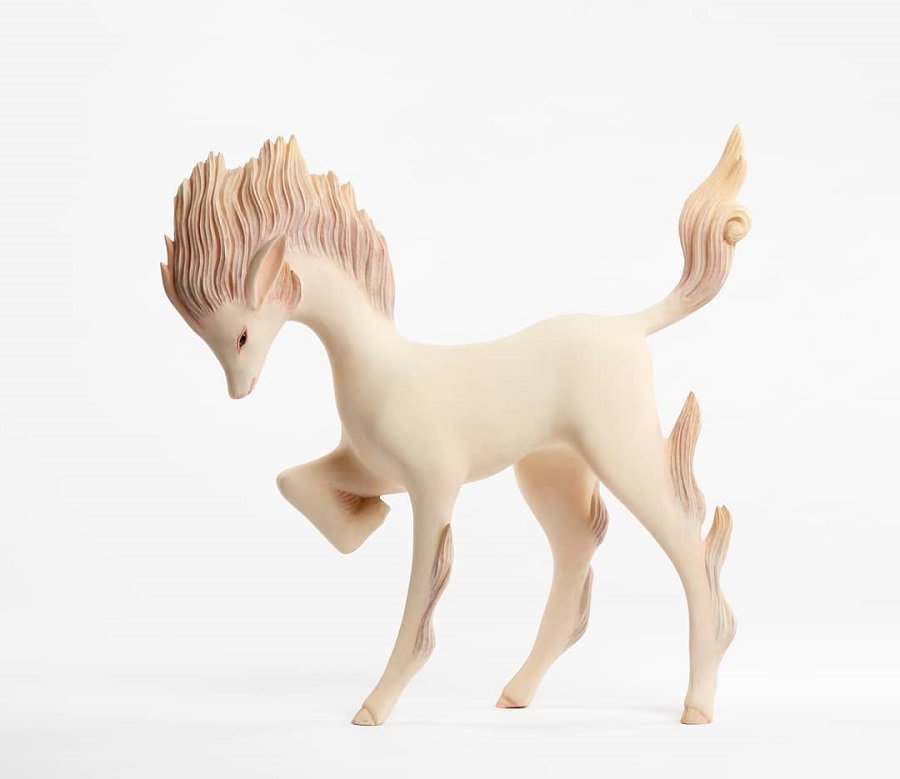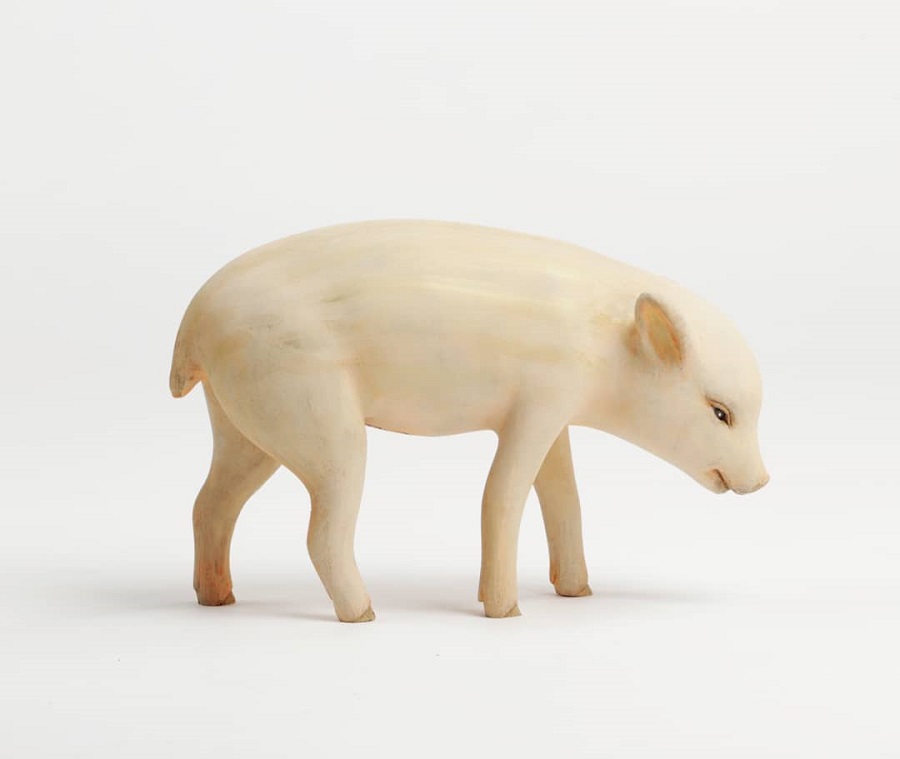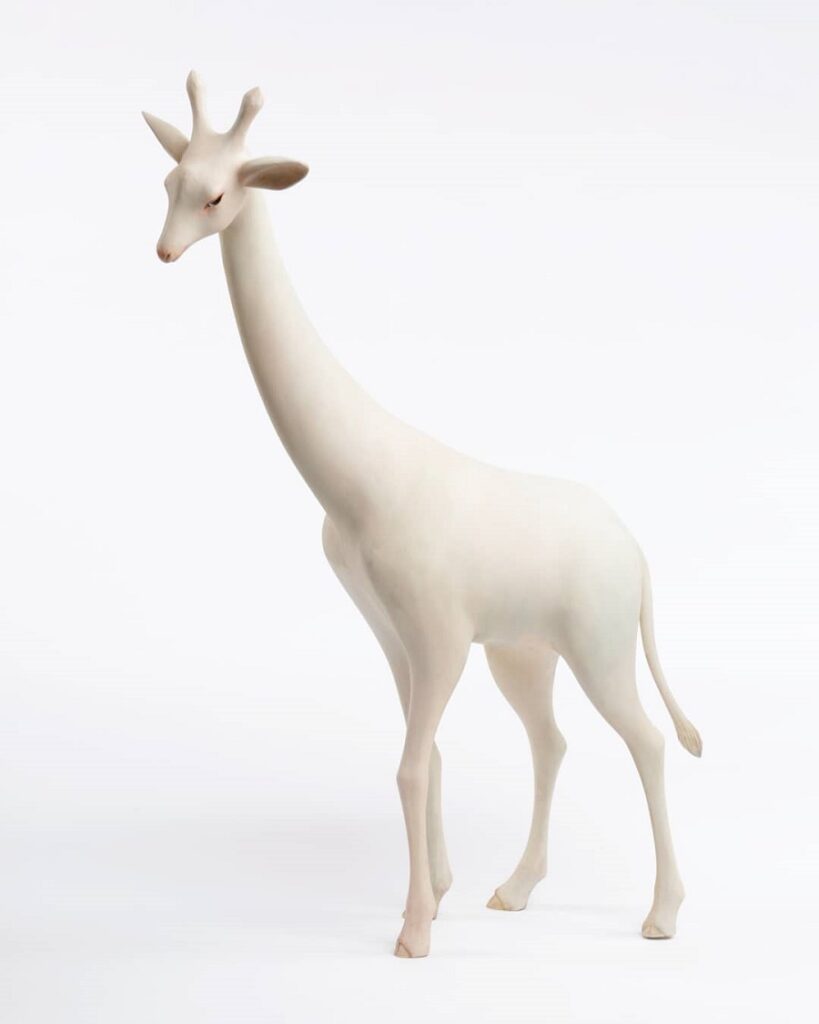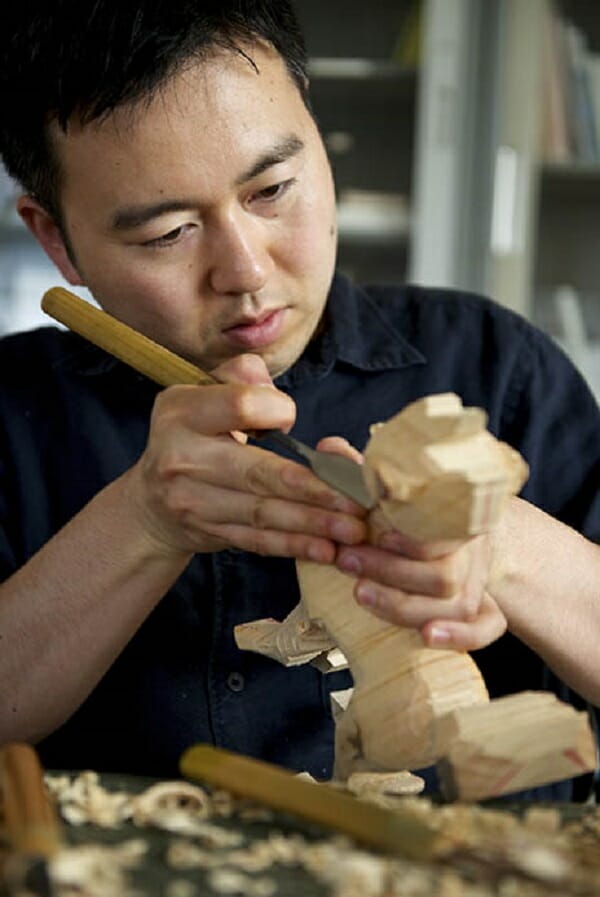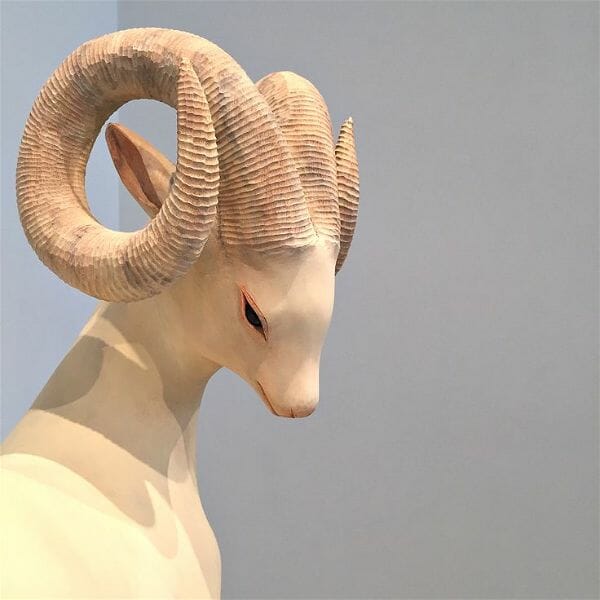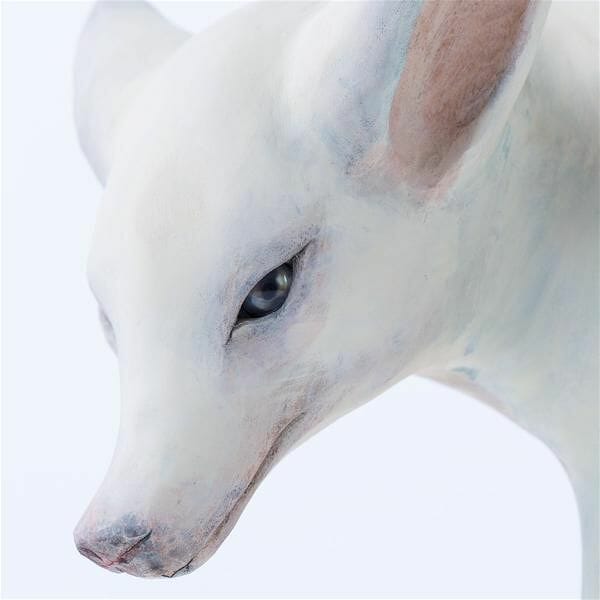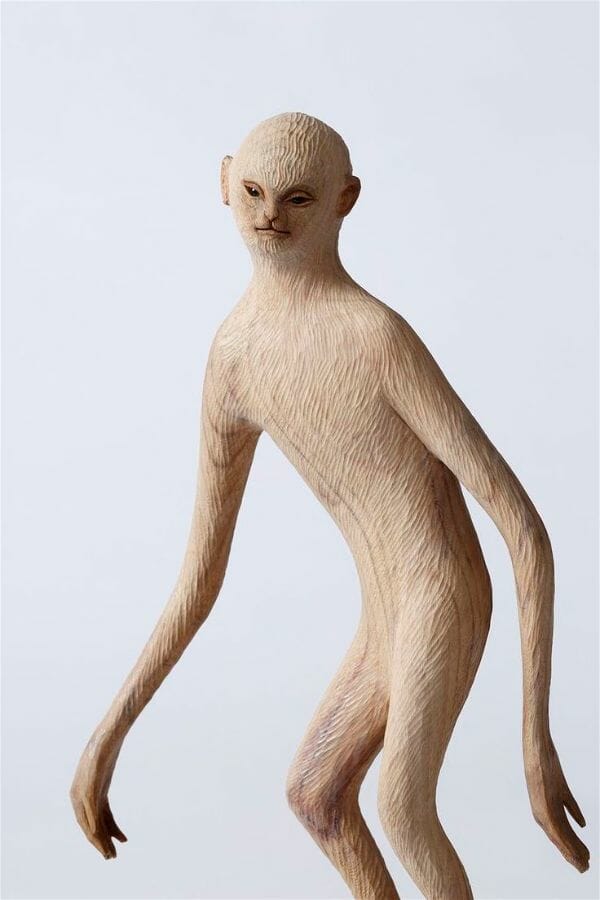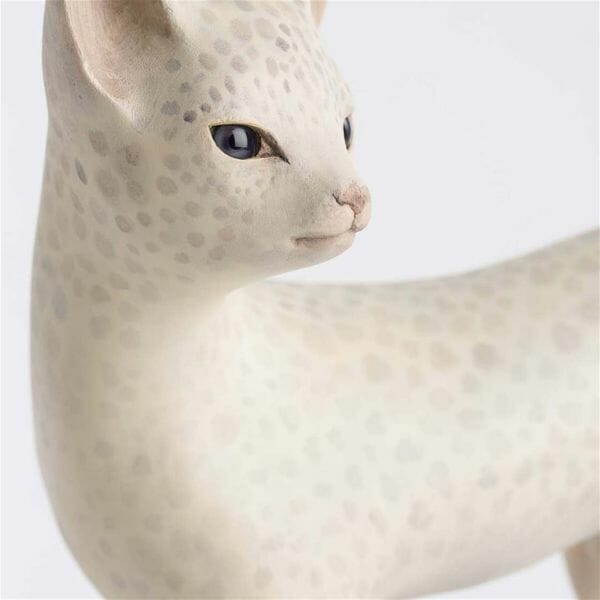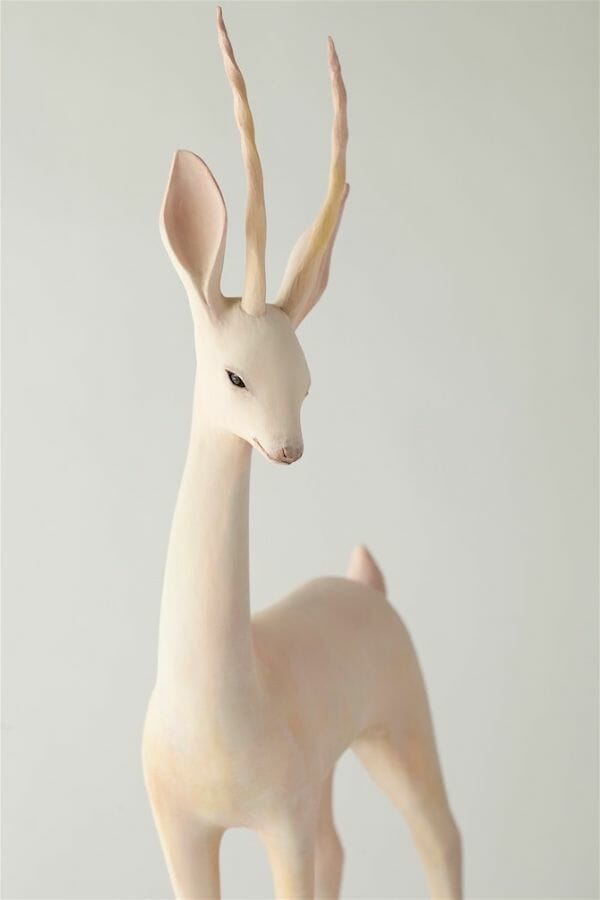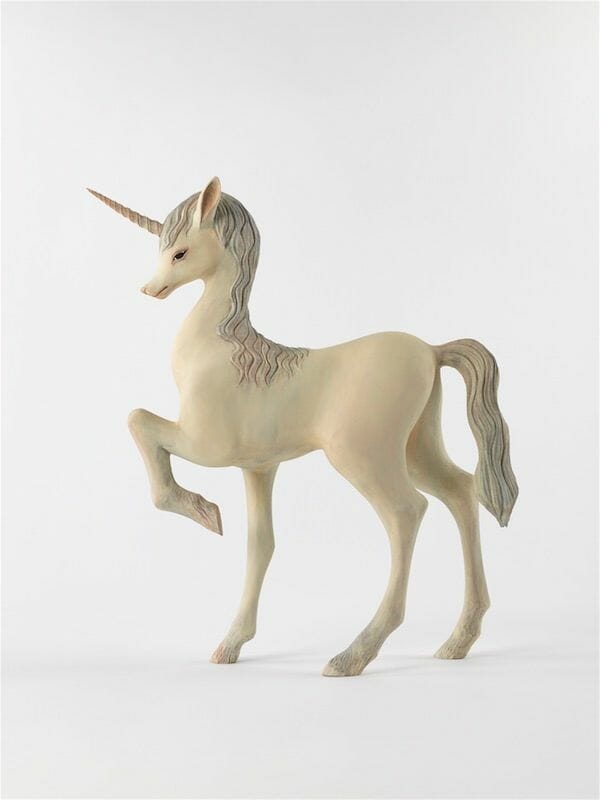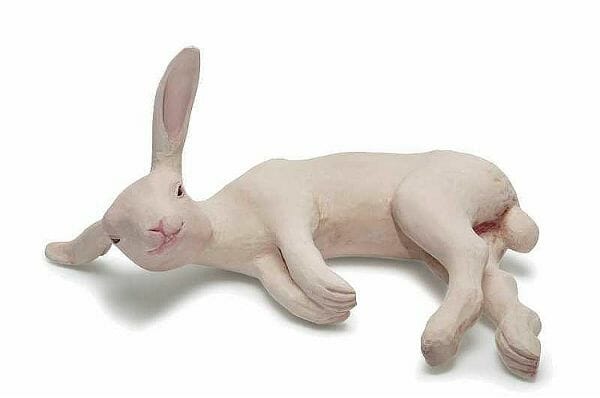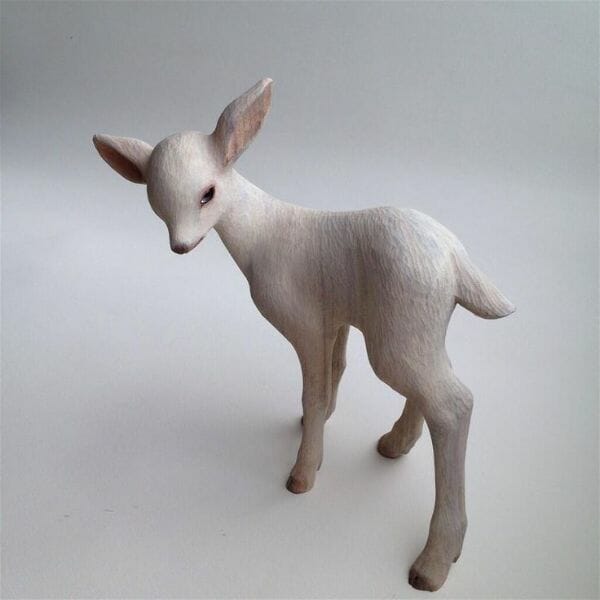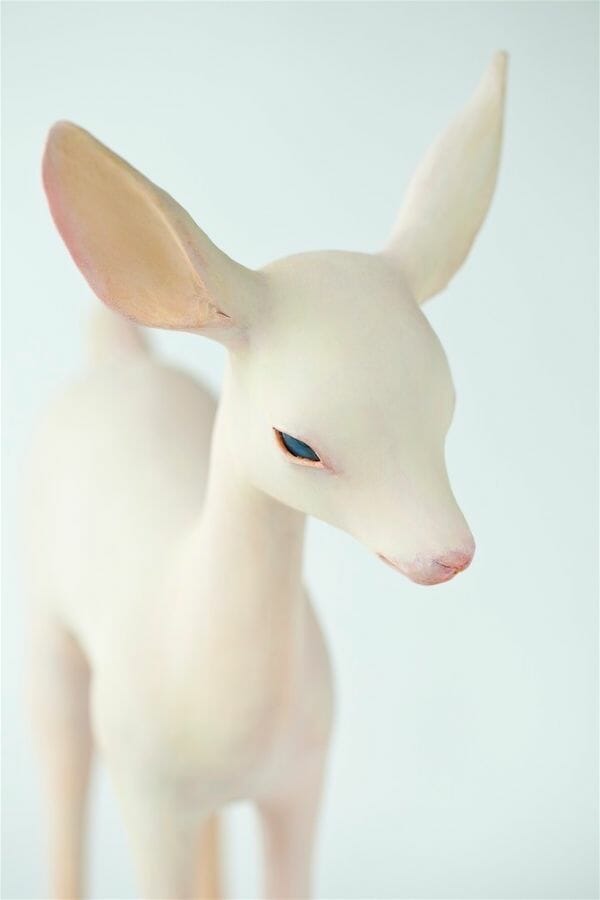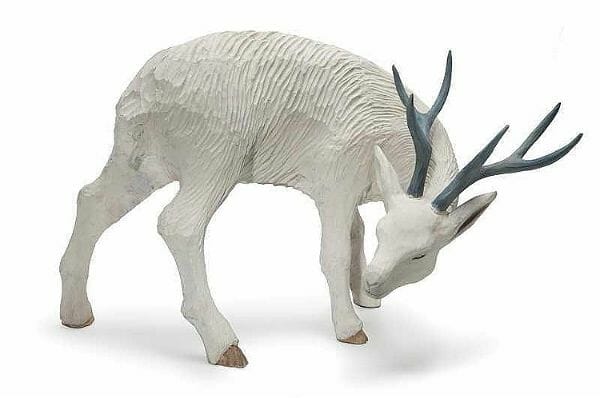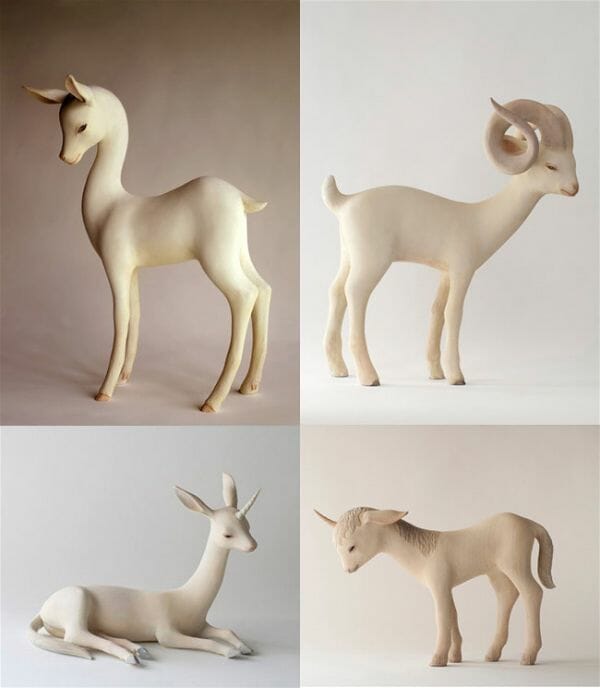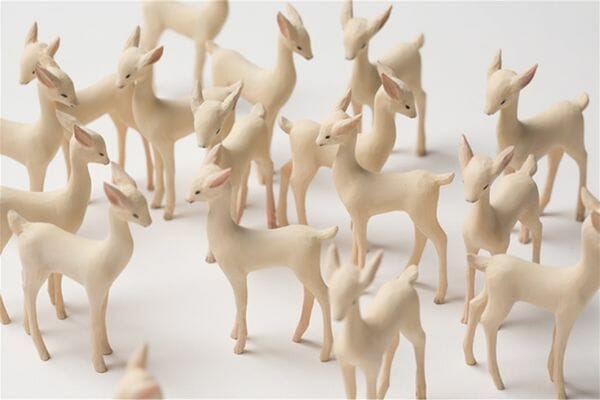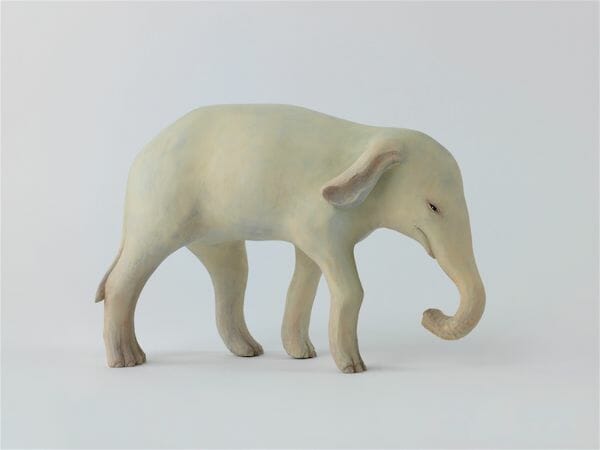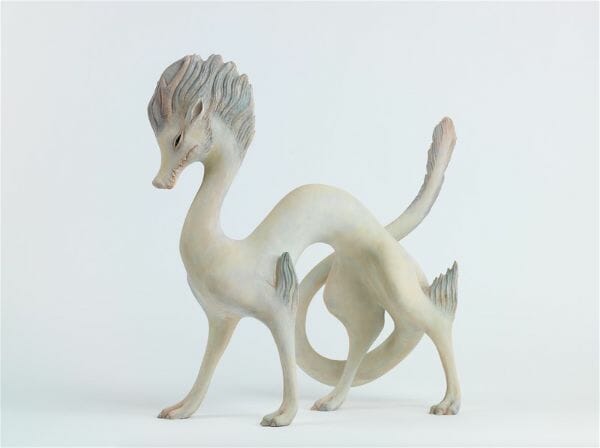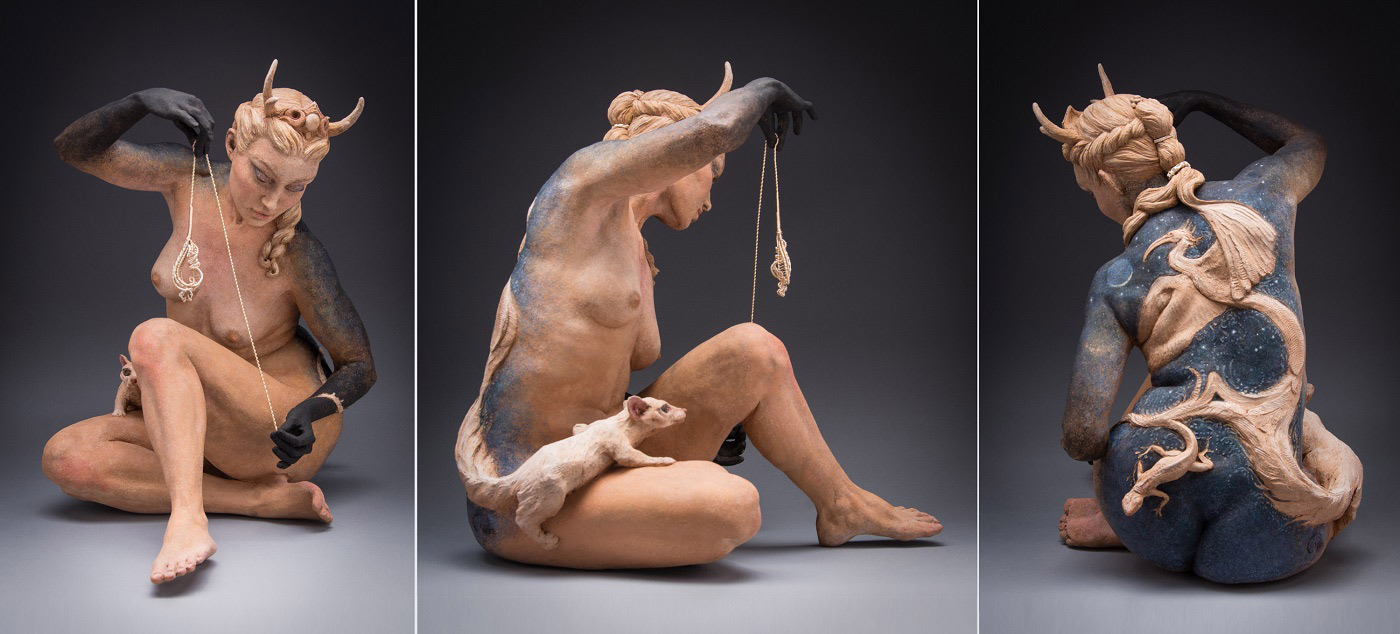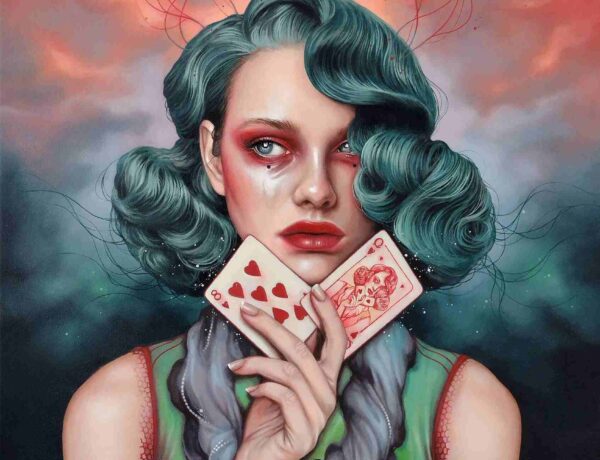Innocent, vulnerable, pure, elegant. These are the creatures born from the visionary mind of Japanese wood carver Yoshimasa Tsuchiya. As a young student, his teachers and classmates understood him best through his artwork, and in college, Yoshimasa continued exploring various media: clay, metals, stone, and finally, woodcarving, the latter hitting the artist’s sweet spot.
Venturing further into woodcarving, Yoshimasa Tsuchiya strayed from representational works and began creating motifs born from his imagination. Much of the artist’s work is life-sized, which means he’s adept at wielding tools such as chainsaws, hand saws, electric drills, hammers, and sharp knives. Read on to discover how this diligent and hyper-focused artist produces a menagerie of animals and figurative work that (we hope) will grace our most fantastical dreams.
I started making animal motifs with my own imagination instead of the realistic posture of the animals. I learned cultural property preservation science in my master and doctoral course. In Japan, there are still wood curved sculptures of Buddha from more than one thousand years ago and I was attracted to the beauty.
Interview with Yoshimasa Tsuchiya in conjunction with his editorial in Issue 20 of Beautiful Bizarre Magazine.
It is always interesting to hear about how artists were as students so let’s start there. What was your favorite subject in high school and why?
My favorite subject was art, of course. I felt my teachers and classmates understood me through my works and I thought I could express myself by my artwork. I also liked science. The way of genetic organisms became hints for the variety of my work.
In 2003, you completed your Master’s degree and in 2007 you completed your doctoral degree. What subjects are your Master’s and doctorate in?
I took department of sculpture of art section in the University. I used stones, clay, metals and then I tried woodcarving. When I carved wood for first time, I thought, “This is it.” I felt the comfortable feeling like gnawing on fruits when I carve the wood. I started making animal motifs with my own imagination instead of the realistic posture of the animals. I learned cultural property preservation science in my master and doctoral course. In Japan, there are still wood curved sculptures of Buddha from more than one thousand years ago and I was attracted to the beauty. I then wanted to know more about them. I copied the wood curved sculpture of Buddha that had been created 1300 years ago and studied the techniques. I was attracted to the job of repairing statues of Buddha but eventually the feeling of creating my own works became stronger, so at the same time I learned classical sculptures while getting my Master’s and Phd. I then started making my own animal art at home.
You had your first solo exhibition roughly ten years ago, in 2007. Can you talk about how that felt for you?
When I had my first solo exhibition, there were people who told me their feelings about my works but I couldn’t take those words as truth and felt so uncertain. When I was a student, I had various part time jobs while studying so I couldn’t spend lot of time on my art. By the end of the exhibition, there were people purchasing my art works and I was receiving the money for it, it was then that I felt this is an accomplishment. I had the desire to live for my arts, yet on the other hand, I felt guilt that I didn’t take the job for repairing statues of Buddha even though I studied for it my Master’s and doctoral degrees. I used to feel guilty for running away from the job every time I saw old statues of Buddha.
From 2008 to 2012, you have participated in multiple group and solo exhibitions. Do you recall a favorite solo show you could tell us about?
I had five solo exhibitions at MEGUMI OGITA GALLERY and I remember the first one very well. I created animals like deer and cats from the beginning of my career. I had image motifs of unicorns, mermaids in my head but as much as I wanted create them, and I felt embarrassed to make something so childish. However, at my solo exhibition in 2009, I determined to make them even if some may think it’s childish. At the exhibition, I had a sense of accomplishment and the voice of the denial of calling it “childish” in my head was gone.
I am curious about the people who have purchased your sculptures. Can you tell me about some of your collectors?
I truly appreciate those who purchase my works. They are the people who give me energy to create my next art. There are various types of clients but separated into two groups. One of them is people who come to me and talk to me. The other groups are those who I don’t know names or their faces but watch my works from afar. If anything, there are more of these types of clients than the first mentioned. I do appreciate the collectors but I try not to interact with them too much because I get confused by the images of my work that pop in my head if it is for someone specific or if it is coming from my own pure ideas.
Where do you go to look at your animal subjects? Do you go to friend’s houses, zoos, museums or animal shelters?
I have cats at home and I like zoos but I try not to copy the real posture of animals. For instance, there are animals as symbols in horoscopes or old tales. Foxes are the symbol of deviousness and dogs are the symbol of loyalty. I think those images of animals differ in time or countries but I create my image of works like, as something is borrowing the posture of the animals and it’s suddenly appearing in front of me. For example, nobody has ever seen unicorns but I imagine the shape of the unicorn by knowing the characteristics of their horns as medicine and that they don’t get attached (domesticated) to humans. In the process, I may use the pictures of a real animal as a reference to physiology but try not to use exact shape of those real animals as I make my works.
Before creating/engraving a wood carving work, I read that you make a prototype model and then you make a rough, flat paper outline of the sculpture that you tape to the wood piece the sculpture will be carved from. Is this how you currently work? Can you tell us more details about your artistic process?
The technique of placing paper on wood comes from the same process of making statues of Buddha. The process is to first enlarge the drawing from sacred books and then draw the outline on the wood. Then, start carving to three-dimension. When I create animals, I draw the lines on the paper and cut it out, then put the paper on the wood and start carving. When I make complicated poses, I first create a little prototype to try it out. I start carving when the image is solidifying in the drawing process.
I don’t change poses once I start carving the wood. After I carve the outline, I decide the lines of the jaw to the tail. Once I settle the outline of the spine, I start making the head, shoulder, and waistlines. After I determine the placement for the shoulder and back, I set the angle of hands and legs.
For the process of making faces, I cut the part of the jaw to head out first and scoop out a cavity inside and then put eyes inside the face. For the expression on the face and small parts, I determine by drawing lines, delete the lines when I feel something is wrong, then draw the lines again, and repeat this process until I find the way. The images of the faces sometimes differ than the one I draw on the paper. The best way of creating the art is not to think too much but gradually complete it in the natural way.
Please tell me about the tools you use to cut out your sculptures from a block of wood. I know you use a chainsaw early on in the process.
After I determine the outline of the sculpture, I use chainsaws for the larger size of the works and hand saws for small ones. I use electric drills often as well. It makes it easier to cut off unwanted parts by making holes on the outlines. I also use hammers and chisels; I’m particular about the sharpness of my tools. I can’t carve the shape I want with blunt knives.
Have you ever hurt yourself badly while making a sculpture? Can you tell us about it?
I have never been injured badly, yet, but I’m always terrified. When the knives are not sharp, I may lose my control and have the possibility of getting hurt, so I sharpen my tools often. Also, lack of sleep and exhaustion may cause injury so I’m always careful.
Do you listen to music while you work? If so, what type of music?
No, I don’t really listen to music while I’m working.
What is your favorite step in the sculpting and finishing process?
My favorite steps are scooping out the inside of the face and putting in crystals for eyes. That is the moment the piece of wood suddenly feels a sense of life. I like the process of painting when I put soft red color in the eyes or ears. The color gives feeling of bloodstreams in the animals.
In 2007 and 2008, you were making goldfish. How is the goldfish important to you symbolically, or was it that you enjoyed the look of the animal and therefore found it pleasing subject material?
People have breed improvements over various creatures. These creatures are bred for enjoyment of people to look them. They cannot survive by them self and I think it’s curious to look at it. I feel sorry for them, at the same time I think they are clever creatures because they control humans to take care of them. Goldfish is the symbol of curious human ego.
In one of your goldfish sculptures from 2007, the media used is listed as cypress tree sculpture (woodcarving, polychrome and amber). Can you explain the reason you use cypress tree wood and tell us about how you made the parts of the fish that are constructed from polychrome and amber?
Cypress trees are good for sensitive wood carving works. I used the cypress wood to make thin fins just like flowers with the body with scales. I cut the body half then scoop out the face area and put amber eyes from inside. I used dowels for the root of the tail parts and tail fin.
I read that some of the creatures you have created were inspired by dreams you have had. Can you say more about this?
It is a lucky thing to see in dreams when I am having a hard time making images for my works. When I see dreams of unusual creatures, I surprise myself for the difference of color and sizes than what I was actually thinking of. For instance, the Phoenix, I saw in a dream was green and no bigger than large pigeons then I thought, “Oh, it is that small.”
Another time I saw a fawn sized unicorn running away on the river between mountains. Sometimes I see subjects in dreams as someone else’s arts. Maybe the experience and the things I was thinking of during the daytime are mixed up in my dreams. I tried to make those images from the dreams into actual shape but it does not really work that way.
You make real animals as well as fantasy creatures such as the phoenix and mermaid. Which do you like making better?
I like making both of them. Roughly speaking, I make the real animals with simple image without ornaments and I make fantasy creatures with many kinds of decorations such as horns, mane, etc. When I am making something simple for example, a motif, I then start wanting to make something gorgeous. It is the same principle as when I am making something big. I then want to make something small on the next one. Or when I creating standing pose, I want to try sleeping pose.
While on the subject of fantasy creatures, what do the mermaid, unicorn, and phoenix symbolize for you?
I am imagining the mermaid as if I see the earth from the universe and I personify the earth. It is fresh and young but lonely and sad but still there is strength inside. The unicorn has medicine inside their horns and is used to treat poisons but they don’t come around to the humans so it is hard to catch them. I had an image of the unicorn, pure and sharp but still a young beast.
The phoenix is another fantasy creature; it is the image/symbol of fortune and it appears often before something good will happen. I wondered if something I cannot see with my eyes such as peace or happiness is borrowed from the shape of the bird as it sweeps down from the sky. I ask myself, “what kind of shape would it be” but I think imagining the shape of peace and happiness is exactly what it is.
I see that you have sculpted a sea monster with flippers that looks like “Nessie” the Loch Ness monster. Can you tell me more about this creature and what it was based upon?
I made my “Nessie” when I joined the group exhibition theme “aquariums.” Everybody knew Nessie when I was a kid but I wonder if kids nowadays know about Nessie. It will probably fade out from the memories. “Nessie” was the dream that everybody in my time wanted to believe. I wanted to create it before everybody forgets about Nessie forever.
I don’t see many fierce creatures or predatory creatures in your body of work. Have you ever made any?
In recent years, I’ve been making more motifs of predatory animals. In the beginning of my career, I had technical problems to make these animals. In order to create the face of predatory animals, I wanted to make very clear eyes that they use to chase other animals but I couldn’t express the eyes with crystals. The result of trial and error, I order beautiful glass eyes from my friend Fukuo Tanaka who is a glass artist and I use the eyes for predatory animals such as cats, lions, foxes.
What was one of your favorite animals to sculpt and why?
I made a sheep as my product for my university graduation. Not the realistic shape of the animal, I chose the theme “Spiral”, then deformed the symbol of life. The sheep has curled horns and posed with a twisted body. It was my an unripe work but my professor, Takashi Fukai acknowledged my artwork and pushed me by telling me “you go with this style,”. This was the first work that I expressed my own image.
Do you think it is important for a person to own a pet of some kind? Why?
It is very fun to have pets. However, I’m not sure if the animals are happy about it. I want them to be happy as much as possible. I’m opposed to selling animals in pet stores. I hope more people rescue them from animal shelters and give animals forever homes.
How were animals involved in your life when you were a young child?
I was very interested in animals but I spent my childhood in the community homes area (high density) of the city and I wasn’t allowed to have a pet. I didn’t really have an opportunity to interact with real animals. Even so, every time when I saw real animals I had imaginations of them and wondered what they were thinking.
Did you have a favorite toy of stuffed animal as a child? If so, what was it?
Yes, I did. It was a tiny animal that about the size of a child’s hand and made of ceramic. The surface of the animal was surrounded by fibers like downy fur. I had a couple of them like a squirrel, a raccoon, and a cat. Now, I think about it, maybe they were the basis of images of my works.
Were animals in your dreams when you were a child?
Yes, I think it was all the time.
I’m assuming some of your subject matter comes from books you read and looked at as a child. Tell us about some of your favorite children’s books.
I used to like “Elmer and the Dragon” I don’t remember the story well but I think the story was about a boy with a kind dragon. I also liked the books of Leo Lionni. My mother liked to read books so she used to take me to the library and she used to read me books when I couldn’t read yet. I liked picture books but I really loved reading illustrated reference books. I used to enjoy imagining tropical insects, birds, extinct animals and creatures that I had never seen before.
“Where the Wild Things Are,” by Maurice Sendak, is an award-winning children’s picture book published in 1962. Some of the imagery in this book reminds me of your sculptures. Are you familiar with this book?
I know the movie came out but I never really read the story before. I think I will read it one day.
There are pictures of beautiful flowers on your Instagram page. Do you grow flowers yourself as a gardener or do you visit other gardens to admire the beauty in nature?
I grow lot of flowers at my home/studio. There are lotus flowers, roses, lilies, and Dutchman’s pipe cactus, etc. I like big flowers. I think the shapes of plants are like abstract sculptures. I never get tired of watching them change shape and color time to time and there are full of hints of my artworks. I take care of my garden when I find time. Sometimes, I’m busier taking care of my garden than spending time to make my arts. I buy them every time I see flowers that I like at stores so my garden is full of flowers. One day, I would like to go to the beautiful gardens of the world.
How do you like to spend your leisure time?
If I had free time and money, I would buy my favorite tools and materials and make my artworks so there is no boundary line between work and free time. It’s my job to create my artworks in my studio and taking care of my flowers at my garden but they are my hobby as well. I also enjoy when I go out for my exhibitions here in Japan or foreign countries.
Please tell us about books you have read and enjoyed recently.
“Novelist as a profession” by Haruki Murakami.
What are a couple of your favorite bands or recording artists
I don’t really have any.
How do you feel about zoos?
I feel appreciation that these beautiful animals can be seen, at the same time, I feel sorry for those animals that are captured in cages. In recent years, some zoos are trying to keep a natural environment as much as possible for the animals and some zoos have succeeded in breeding endangered animals. I hope the system of the zoos become more like a sanctuary and study for animal protections not only for amusement of people.


